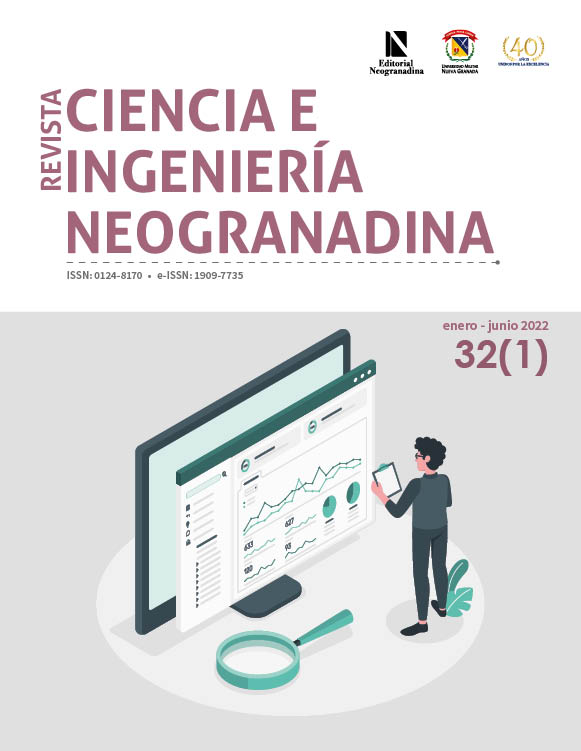Performance period of prefabricated asphalt mixtures stored for patching activities in Bogotá D.C.
Abstract
The objective of this work is to determine the performance period of three prefabricated asphalt mixtures used for patching activities in flexible pavement. The materials were evaluated by granulometry tests, bulk specific gravity, and maximum specific gravity. The performance of the mix- tures was evaluated through stability and flow tests, Cantabro and rutting tests, resilient modulus, trapezoidal fatigue and evaluation of susceptibility to water by indirect traction (TSR). According to the results for mixture I, the conclusion is that this material is not recommended for use, since it pre- sented unfavorable performance during and after laboratory tests. For type II and III mixtures, the evaluation of the number of equivalent axes was determined using the French mechanistic empirical and AASTHO-93 methodologies. As a result of the modeling, it was evidenced that the mixtures sup- ported low traffic classified between T1 and T2, with a performance period for the type II mixture between five and six months, and for the type III mixture between one and fifteen months. Results obtained according to the evaluated methodology. It was concluded that mixtures type II and III are adequate mixtures to carry out emergency interventions in road corridors that support low traffic.
Downloads
References
J. Coronado, Manual centroamericano de mantenimiento de carreteras. Escuintla, Guatemala: Secretaría de Integración Económica Centroamericana, 2000, pp. 1-289.
Asphalt Institute, The asphalt handbook. Asphalt Institute, 1989.
H. Solminihac, Gestión De infraestructura vial. Santiago de Chile: Ediciones Universidad Católica de Chile, 2018, pp. 1-508. doi: https://doi.org/10.2307/j.ctvkjb4dw
Instituto de Desarrollo Urbano, “Inventario de huecos en Bogotá D.C.”, 2015. https://www.idu.gov.co/Archivos_Portal/Transparencia/Informacion%20de%20interes/SIIPVIALES/Innovaci%C3%B3n/Portafolio/2017/09%20Septiembre/Otros/02%20variacion_extension_malla_vial_bogota_2004_20z.pdf.
C.W. Huang, T. H. Yang y G.B. Lin, “The evaluation of short- and long-term performance of cold-mix asphalt patching materials”, Advances in Materials Science and Engineering, vol. 2020, pp. 1-11, Jul. 2020, doi: https://doi.org/10.1155/2020/8968951
S. Huang, J. Ren, M. Li et al., “Development and evaluation of solvent-based cold patching asphalt mixture based on multiscale”, Advances in Materials Science and Engineering, vol. 2020, pp. 1-16, Oct. 2020, doi: https://doi.org/10.1155/2020/1984972
M. E. Piletskii, I. V. Didrikh, A. F. Zubkov et al., Pothole maintenance of non-rigid paving surfaces using the injection flow method”, Scientific Herald of the Voronezh State University of Architecture & Civil Engineering., vol. 38, no. 2, pp. 47-57, 2018.
Instituto Nacional de Vías, “Manual para la inspección visual de pavimentos flexibles”, 2006.
P. Cui, Y. Xiao, M. Fang et al., “Residual fatigue properties of asphalt pavement after long-term field service”, Materials, vol. 11, no. 6, p. 892, 2018. doi: https://doi.org/10.3390/ma11060892
S. Biswas, L. Hashemian y A. Bayat, “Investigation of pothole severity and maintenance methods in Canada through questionnaire survey”, Journal of cold regions engineering, vol. 32, no. 2, p. 04018002, 2018. doi: https://doi.org/10.1061/(ASCE)CR.1943-5495.0000161
S. S. Adlinge y A. K. Gupta, “Pavement deterioration and its causes”, International Journal of Innovative Research and Development, vol. 2, no.4, pp. 9-15, 2013.
H. A. Rondón y F. A. Reyes, Pavimentos materiales, construcción y diseño. Bogotá: ecoe, 2015, pp. 1-573.
M. Liu, S. Han, W. Shang et al., “New polyurethane modified coating for maintenance of asphalt pavement potholes in winter-rainy condition”, Progress in Organic Coatings, vol. 133, no. 2019, pp. 368-375, 2019. doi: https://doi.org/10.1016/j.porgcoat.2019.04.059
A. Jimenez, J. P. Bocarejo, R. Zarama et al., “A case study analysis to examine motorcycle crashes in Bogota, Colombia”, Journal of safety research, vol. 52, pp. 29-38, 2015. doi: https://doi.org/10.1016/j.jsr.2014.12.005
Q. Dong, B. Huang y S. Zhao, “Field and laboratory evaluation of winter season pavement pothole patching materials”, International Journal of Pavement Engineering, vol. 15, no. 4, pp. 279-289, 2014. doi: https://doi.org/10.1080/10298436.2013.814772
Q. Dong, B. Huang y X. Jia, “Long-term cost-effectiveness of asphalt pavement pothole patching methods. Transportation research record.” Journal of the Transportation Research Board, no. 2431, pp. 49-56, 2014. doi: https://doi.org/10.3141/2431-07
S. Huang, J. Ren, M. Li et al., “Development and Evaluation of Solvent-Based Cold Patching Asphalt Mixture Based on Multiscale.” Advances in Materials Science and Engineering, vol. 2020, 2020. doi: https://doi.org/10.1155/2020/1984972
Instituto de Desarrollo Urbano, “Especificaciones técnicas-sección 570-11: parcheo y bacheo”, 2011.
H. Obaidi, B. Gomez-Meijide y A. García, “On-site manufacture of hot mix asphalt using pellets that can be melted by induction energy”, Powder Technology, vol. 344, no. 2019, pp. 58-67, 2019. doi: https://doi.org/10.1016/j.powtec.2018.11.089
Instituto de Desarrollo Urbano, “Especificaciones técnicas-sección 571-11: parcheo mecanizado”, 2011.
P. A. Torres-Linares, J. P. Aguiar-Moya y L. G. Loría-Salazar, “Evaluación del desempeño y metodología de diseño para bacheo mediante técnica de inyección”, Universidad de Costa Rica, 2016.
M. E. Piletskii, K. A. Andrianov y A. F. Zubkov, “Influence of the load-carrying capacity of vehicles when performing repair works of road pavements by means of the jet-injection method”, Russian Journal of Building Construction and Architecture, vol. 45, no. 1, 2020.
M. D. Nazzal, S. S. Kim y A. R. Abbas, “Evaluation of winter pothole patching methods,” The National Academies of Sciences, Engineering, and Medicine, 2014. https://rosap.ntl.bts.gov/view/dot/27019
Q. Dong, C. Dong y B. Huang, “Statistical analyses of field serviceability of throw-and-roll pothole patches”, Journal of Transportation Engineering, vol. 141, no. 9, 2015. doi: https://doi.org/10.1061/(ASCE)TE.1943-5436.0000786
S. Biswas, L. Hashemian,, M. Hasanuzzaman et al., “A study on pothole repair in Canada through questionnaire survey and laboratory evaluation of patching materials”, Canadian Journal of Civil Engineering, vol. 43, no. 5, pp. 443-450, 2016. doi: https://doi.org/10.1139/cjce-2015-0553
J. F. Amado-Marin, “Análisis del sistema de reparación de pavimentos flexibles por inyección neumática de mezclas asfálticas en frío, tecnología velocity patching”, Tesis de grado, Universidad Distrital Francisco José de Caldas, 2015.
Instituto Nacional de Vías, “Especificaciones generales de construcción de carreteras”, 2013.
Instituto de Desarrolllo Urbano, “Especificaciones técnicas-sección 580-11”, 2011.
C. Fonseca, V. Serment y R. Villalobos, “Dosificación de mezclas asfálticas abiertas y drenantes empleando el método de ensayo Cántabro de pérdidas por desgaste”, National Academies of Sciences, Engineering, and Medicine, no. 1, pp. 145-154, 1999.
Normalización Española, “une‐en 12697-22:2008+A1:2008. (Mezclas bituminosas. Métodos de ensayo para mezclas bituminosas en caliente. Parte 22: ensayo de rodadura.)”, 2008.
M. Muniz de Farias, F. Quiñonez-Sinisterra y H. A. Rondón-Quintana, “Behavior of a hot mix asphalt made with recycled concrete aggregate and crumb rubber”, Canadian Journal of Civil Engineering, vol. 46, no. 6, pp. 544-551, 2019. doi: https://doi.org/10.1139/cjce-2018-0443
astm, D4123, “Standard test method for indirect tension test for resilient modulus of bituminous mixtures”, 1982.
A.S. Figueroa, F. A. Reyes, D. Hernández et al., “Análisis de un asfalto modificado con icopor y su incidencia en una mezcla asfáltica densa en caliente”, Ingeniería e Investigación, vol. 27 no. 3, pp. 5-15, 2007.
Normalización Española, “une‐en 12697-24. (Mezclas bituminosas. Parte 24: Resistencia a la fatiga.)”, 2019.
F. A. Reyes-Lizcano, Diseño racional de pavimentos. Bogotá: Escuela Colombiana de Ingeniería, 2003, pp 1-584.
J. Vera, “Caracterización de mezclas asfálticas por su resistencia a fatiga por reflexión”, Tesis de maestría, Pontificia Universidad Javeriana, 2012.
F.A. Reyes-Lizcano y A.S. Figueroa, Usos de desechos plásticos en mezclas asfálticas. Bogotá: Editorial Pontificia Universidad Javeriana, 2008, pp. 1-99.
F. Xiao, P. W. Zhao y S. N. Amirkhanian, “Fatigue behavior of rubberized asphalt concrete mixtures containing warm asphalt additives”, Construction and Building Materials, vol. 23, no. 10, pp. 3144-3151, 2009. doi: https://doi.org/10.1016/j.conbuildmat.2009.06.036
Ministerio de Fomento de España. “(PG‐3): Artículos 542‐Mezclas bituminosas en caliente tipo hormigón bituminoso y 543‐Mezclas bituminosas para capas de rodadura. Mezclas drenantes y discontinuas”, 2008.
A. S. Figueroa y F. A. Reyes, “Análisis de la susceptibilidad al daño por humedad de una mezcla asfáltica a partir del ensayo mist y del programa ipas 2D®”, Infraestructura Vial Lanamme ucr, vol. 17, no. 30, pp. 31-39, 2015. doi: https://doi.org/10.15517/iv.v17i30.22926
O. J. Reyes, J. F. Camacho, y A. Nieto, “Cambios en las propiedades dinámicas de una mezcla asfáltica por energía de compactación y variación en la granulometría”, Ciencia e Ingeniería neogranadina, vol. 16, no. 1, pp. 72-79, 2016. doi: https://doi.org/10.18359/rcin.1248
X. Li, M. O. Marasteanu, A. Kvasnak et al., “Factors study in low-temperature fracture resistance of asphalt concrete”, Journal of Materials in Civil Engineering, vol. 22, no. 2, pp. 145-152, 2010. doi: https://doi.org/10.1061/(ASCE)0899-1561(2010)22:2(145)
B. Yang, B. Xiong, Y. Ji et al., “Experimental study of the fatigue performance of open-graded asphalt mixture friction course”, Materials Research Innovations, vol 19, no. 5, S5464-S5-464, 2015. doi: https://doi.org/10.1179/1432891714Z.0000000001132
H. Wu, B. Huang, y X. Shu, “Characterizing fatigue behavior of asphalt mixtures utilizing loaded wheel tester”, Journal of materials in civil engineering, vol. 26 no. 1, pp. 152-159, 2014. doi: https://doi.org/10.1061/(ASCE)MT.1943-5533.0000791
N. B. Patiño, O. J. Reyes y J. F. Camacho, “Comportamiento a fatiga de mezclas asfálticas colombianas con adición de pavimento reciclado al 100%”, Tecnura Tecnología y cultura afirmando el Conocimiento, vol. 19, no. 43, pp. 74-83, 2015. doi: https://doi.org/10.14483/udistrital.jour.tecnura.2015.1.a05
H. Malladi, D. Ayyala, A. A. Tayebali et al., “Laboratory evaluation of warm-mix asphalt mixtures for moisture and rutting susceptibility”, Journal of Materials in Civil Engineering, vol. 27, no. 5, pp. 04014162-1-04014162-6, 2015. doi: https://doi.org/10.1061/(ASCE)MT.1943-5533.0001121
Y. Bi, R. Li, S. Han et al., “Development and performance evaluation of cold-patching materials using waterborne epoxy-emulsified asphalt mixtures”, Materials, vol. 13 no. 5, p. 1224, 2020. doi: https://doi.org/10.3390/ma13051224
A. H. Mrema, S. H. Noh, O. S. Kwon et al., “Performance of glass wool fibers in asphalt concrete mixtures”, Materials, vol. 13, no. 21, p. 4699, 2020. doi: https://doi.org/10.3390/ma13214699
H. A. Rondón y F.A. Reyes-Lizcano, “Metodologías de diseño de pavimentos flexibles: Tendencias, alcances y limitaciones”, Ciencia e Ingeniería Neogranadina, vol. 17, no. 2, pp. 41-65, 2007. doi: https://doi.org/10.18359/rcin.1074
Ziari, H., Aliha, M. R. M., Mojaradi, B., & Jebalbarezi Sarbijan, M. (2019). Investigating the effects of loading, mechanical properties and layers geometry on fatigue life of asphalt pavements. Fatigue & Fracture of Engineering Materials & Structures, 42(7), 1563-1577. doi: https://doi.org/10.1111/ffe.12928
Instituto de Desarrollo Urbano “Guía de pavimentos para bajos volúmenes de tránsito y vías locales para Bogotá D.C.”, 2013.
Instituto Nacional De Vías Ministerio de Transporte, Manual de Diseño de Pavimentos asfálticos en vías con medios y altos volúmenes de tránsito. 1998, pp. 1-107.
L. R. Vásquez-Varela y F. J. García-Orozco, “An overview of asphalt pavement design for streets and roads”, Revista Facultad de Ingeniería Universidad de Antioquia, no. 98, pp. 10-26, 2020. doi: https://doi.org/10.17533/udea.redin.20200367
T.P. Wilson y A.R. Romine, “Materials and procedures for repair of potholes in asphalt surfaced pavements-manual of practice”, Washington, Estados Unidos, Rep. FHWA-RD-99-168. 1999.











